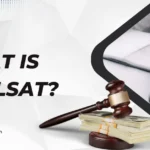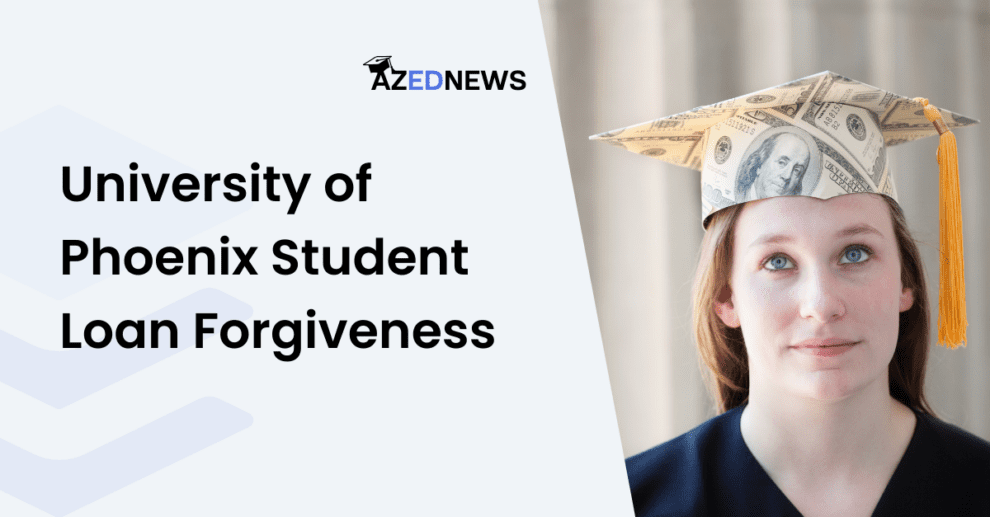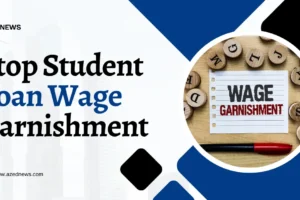If you are looking for information on University of Phoenix student loan forgiveness, you are on the right article. Those borrower students enrolled in the University of Phoenix between September 21, 2012, and December 31, 2014, have good news! Their student loans may be eligible for forgiveness. They can apply for University of Phoenix student loan forgiveness and be relieved of the burden of their federal student loans!
Table of Contents
The University of Phoenix has decided to forgive student loans that meet the University of Phoenix student loan forgiveness criteria. Loan forgiveness is available to University of Phoenix alumni. A portion of the $37 million in student loan forgiveness may be available to them. This is a great initiative of the University of Phoenix to help the borrower students burdened with debt. You can also check our article on University of Phoenix Financial Aid.
This article will give you detailed information about the University of Phoenix student loan forgiveness eligibility criteria and application process. If you are a former student of this university, check your eligibility, and take advantage of the institution’s loan forgiveness opportunity.
Key Takeaways
- University of Phoenix is forgiving student loans for some former students.
- To be eligible, you need to have been enrolled between September 21, 2012, and December 31, 2014.
- You must prove that the school misled you.
- You can apply for loan forgiveness through the Borrower Defense program on the Federal Student Aid website. You will need to provide evidence to support your claim.
- The Department of Education will review your application and decide whether to approve it.
- If you are approved, your outstanding student loans will be forgiven.
What is Student Loan Forgiveness?
Student loan forgiveness refers to a federal initiative that relieves eligible borrowers of their remaining student loan debt. The primary program for student loan debt is Public Service Loan Forgiveness (PSLF), which offers forgiveness after 120 qualifying monthly payments during full-time employment in eligible public service positions. Another approach is income-driven repayment (IDR) forgiveness, which applies after 20 or 25 years of eligible payments under income-driven repayment plans.
Student loan forgiveness serves to reduce a portion or all of a borrower’s federal student loan debt. It is important to note that except for coverage for private loans, only federal direct loans are eligible for this forgiveness benefit. Borrowers can qualify for loan forgiveness by engaging in public service work. Additionally, federal loans may be repaid under circumstances beyond the borrower’s control.
Types of Student Loan Forgiveness
- Public Service Loan Forgiveness (PSLF): This includes working in qualified public service roles. After completing 120 eligible monthly payments, the outstanding balance is forgiven.
- Teacher Loan Forgiveness: It is designed for teachers in low-income schools. It forgives up to $17,500 in Direct or Stafford loans after five years of qualifying tuition service.
- Income-Driven Repayment (IDR) Forgiveness: Income-Based Repayment (IBR), Pay As You Earn (PAY), and Modified Pay As You Earn (PAY) are linked to IDR plans. You may be eligible for forgiveness after 20 or 25 years of qualifying payments, but it also depends on your plan.
- Perkins Loan Cancellation: It is available to teachers, special education professionals, and some businesses. Perkins cancels part of the loan for each year of service.
- Closed School Leave: This loan forgiveness applies if the school closes while the student is enrolled or within 120 days of withdrawal. Federal loans can be repaid under these circumstances.
- Total and Permanent Disability (TPD) Relief: It forgives federal student loans for permanently disabled borrowers. A qualified physician’s documentation is necessary.
- Death Discharge: Federal student loans are repaid upon the death of the borrower. The loan servicer is required to submit the death certificate.
- Incorrect Certification of Student Eligibility: The loan will be forgiven if the school incorrectly certifies eligibility or if the loan is made without the borrower’s permission.
- Freedom from Bankruptcy: It is rare, but possible, for cases to present undue hardship in bankruptcy court. It needs to be demonstrated that repayment would cause undue hardship.
- Veteran Total and Permanent Disability Discharge: This loan forgiveness is available to veterans with a service-connected disability. In that scenario, they must present documentation issued by the Department of Veterans Affairs.
- State-Specific Loan Forgiveness Programs: Some states offer unique loan forgiveness programs for residents of specific businesses.
- Loan Forgiveness for Nurses and Health Care Professionals: Various programs for healthcare professionals working in disadvantaged areas or specific areas.
- Federal Family Education Loan (FFEL) Program Loan Forgiveness: This is limited forgiveness options for FFEL loans compared to Direct loans.
- Public Safety Officer Loan Forgiveness: It is designed for law enforcement officers, firefighters, and public safety professionals.
- Armed Forces Loan Forgiveness: Various loan forgiveness programs for military personnel, including military service deferment and public service loan forgiveness for military service members.
Who is Eligible for University of Phoenix Student Loan Forgiveness?
The US Department of Education has announced eligibility for federal student loan forgiveness for students enrolled at the University of Phoenix from September 21, 2012, through December 31, 2014.
Those former students who enrolled at the university in the mentioned period will be eligible for University of Phoenix student loan forgiveness.
Recently, the department announced the approval of loan forgiveness for such individuals, provided they submit a valid application for Borrower Defense. This initiative addresses concerns regarding deceptive practices and aims to provide relief to students who have been affected at the University of Phoenix during the mentioned time frame.
What Specific Criteria Are Considered for University of Phoenix Student Loan Forgiveness?
University of Phoenix student loan forgiveness criteria generally consider the borrower’s eligibility, academic program completion status, and potential instances of misrepresentation or misconduct by the institution. Eligibility often involves the resolution of issues related to deceptive practices.
Meeting specific conditions, such as financial hardship or closure of the institution, may affect the forgiveness process. Borrowers should stay informed about the latest guidelines and refer to official sources for accurate and updated information on the University of Phoenix student loan forgiveness criteria.
How to Apply for University of Phoenix Student Loan Forgiveness?
To seek University of Phoenix student loan forgiveness through the repayment program from Borrower Defense, you must fill out an application, which is available on the Federal Student Aid website, and submit the required documentation. You must describe in your application how the university misled you about your educational or employment opportunities. It will also be important for you to support your statements with evidence. This evidence may consist of:
- Promotional materials from the University of Phoenix
- Admission letter or other records from the university
- Transcripts
- Tuition Details
- Statements from witnesses
- Employment History
After completing your application and gathering the required documents, proceed to submit it to the Federal Student Aid website. The Department of Education will evaluate your application and determine whether to approve or deny your loan forgiveness request. If approved, your outstanding student loans will be forgiven.
Tips to Apply for University of Phoenix Student Student Forgiveness
To apply for University of Phoenix student loan forgiveness, follow the tips mentioned below:
- Visit the Borrower Defense page: If you are enrolled at the University of Phoenix and have not submitted a Borrower Defense claim, begin by visiting the Borrower Defense page for information and submitting a claim.
- Submitting a Claim After Settlement: Even if you received payment from the University of Phoenix Settlement Fund, you are still eligible to apply for University of Phoenix student loan forgiveness through the Borrower Defense Program.
- Detailed Application: Complete your application. Make sure your application is specific and detailed. Explain clearly how the University of Phoenix misled you and what impact it has had on your life.
- Provide Supporting Evidence: Include extensive evidence to support your claims. This may include attaching marketing materials, admissions letters, tuition statements, transcripts, employment records, and witness statements.
- Patience During Review: Understand that it may take several months for the Department of Education to review your application and reach a decision. Be patient during the entire process.
University of Phoenix Student Loan Forgiveness Competitive Landscape
- The University of Phoenix student loan forgiveness program faces stiff competition with 358 peers, and it currently ranks 358th among them. This suggests a competitive landscape and the rankings may influence individuals considering student loan forgiveness options.
- Of the 358 participants in the University of Phoenix Student Loan Forgiveness Program, 11 are currently funded, indicating ongoing financial support. Additionally, 16 competitors have dropped out of the scene, suggesting changes or challenges within the field.
- University of Phoenix Student Loan Forgiveness has garnered substantial support along with its competitors, collectively raising more than $22.8 million in funding. The financing spans 15 funding rounds and includes contributions from 14 investors. The significant investment underscores the perceived value and interest in initiatives addressing student loan forgiveness in this competitive landscape.
- University of Phoenix Student Loan Forgiveness and its counterparts have successfully secured more than $22.8 million through 15 rounds of financial aid funding. This backing comes from a diverse group of 14 investors, highlighting the collective confidence and interest in addressing student loan forgiveness. The substantial funding underlines the importance and feasibility of the initiative in this competitive sector.
- Within the University of Phoenix student loan forgiveness competition set, three companies are publicly traded, indicating transparency and market presence. Additionally, 13 companies have been acquired, suggesting a dynamic landscape with strategic business growth.
How Does the University of Phoenix Handle Situations Where a Student Has Multiple Loans with Different Terms and Conditions?
The University of Phoenix adopts a comprehensive strategy to help students struggling with multiple loans with different terms and conditions. Recognizing the complexities involved, the University advocates federal loan consolidation as an initial step. This consolidation process enables students to merge different federal education loans into one unit, potentially receiving a fixed interest rate based on the average of the consolidated loans. The result often streamlines the repayment process and can result in lower monthly payments.
Additionally, the University actively guides students to opt for income-based repayment plans, such as Income-Based Repayment (IBR), Pay As You Earn (Repay), or Modified Pay As You Earn (Repay). These plans fix the monthly payment amount as per the borrower’s income and family size, providing increased flexibility to people juggling loans with different terms.
The Financial Aid Office at the University of Phoenix plays an important role in this process. This usually provides valuable assistance, including clarifying loan terms, evaluating repayment options, and facilitating the consolidation process. Financial counseling sessions and informational resources are typically offered to empower students to make well-informed decisions about meeting their various loan obligations.
Additionally, the University is poised to develop federal policies related to student loans. This proactive stance ensures that students are kept aware of any modifications to loan forgiveness programs or repayment options.
FAQs
1. How do I get my University of Phoenix loans discharged?
To discharge University of Phoenix loans, explore options like Total and Permanent Disability Discharge, Closed School Discharge, or False Certification Discharge. For specific details and required forms, contact your loan servicer. Visit the Borrower Defense page and file a Borrower Defense claim.
2. How much is a refund check from the University of Phoenix?
The average refund check payment received from the University of Phoenix is $337. A check for students will often arrive in the mail. A refund check from the University of Phoenix can provide a boost to student finances.
3. Can I get my student loans forgiven if I go to the University of Phoenix?
If you attended the University of Phoenix and used federal student loans to pay for tuition, you may be eligible for full loan forgiveness. Check the eligibility criteria, as recent changes may apply. Explore the potential opportunity to reduce your financial burden from past educational expenses at the University of Phoenix through this forgiveness program.
4. Will the University of Phoenix loans be canceled?
The US Department of Education recently approved federal student loan forgiveness for individuals who attended the University of Phoenix, were victims of the school’s deceptive job placement claims, and successfully filed a valid Borrower Defense application.
5. Will private student loans be forgiven?
Private student loan forgiveness programs are uncommon. However, some lenders may offer these options depending on specific circumstances. For example, some lenders consider forgiveness in cases of disability of the borrower or if the primary borrower on the co-signed loan dies. Although these examples are the exceptions, it is important to inquire with the lender about possible relief options tailored to individual circumstances.
6. Can I get my student loans forgiven if I went to the University of Phoenix?
If you went to the University of Phoenix, and you have not asked for loan forgiveness yet, you should check out the borrower defense program. You apply for having your student loans forgiven. Even if you got money from the University of Phoenix settlement before, you can still apply for loan forgiveness through this different program.
7. How do I know if my student loans will be forgiven?
If you have been paying your loans for over 20 or 25 years, your loans could be forgiven right away. People who made 240 or 300 eligible payments under an income-driven plan reach a milestone. At that point, any remaining loan balance is simply forgiven.
Conclusion
The importance of the University of Phoenix Student Loan Forgiveness Program lies in the assistance it provides to financially strapped students. The program attempts to alleviate the financial difficulties of people attending the university by acknowledging their difficulties.
It addresses loan repayment difficulties and promotes greater access to education by providing forgiveness opportunities. Furthermore, it promotes a more equitable approach to higher education by demonstrating a commitment to helping students achieve academic and professional goals.












Add Comment